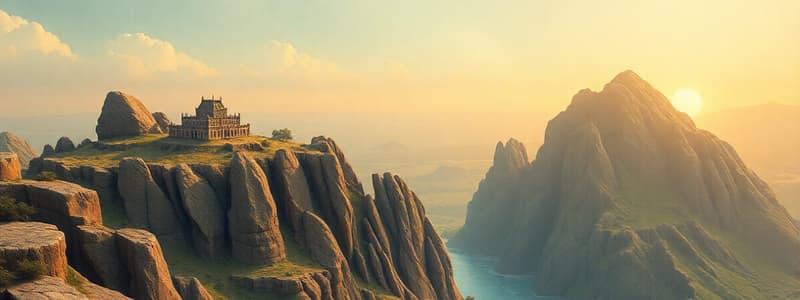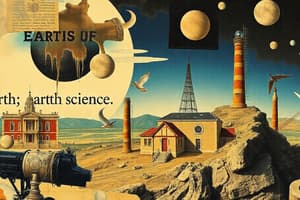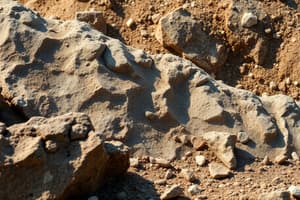Podcast
Questions and Answers
What is the primary focus of historical geology?
What is the primary focus of historical geology?
- The structure and components of the universe
- Weather patterns and climate changes
- Processes and events forming Earth and life (correct)
- The study of ocean tides and waves
Which branch of Earth science helps in predicting weather conditions?
Which branch of Earth science helps in predicting weather conditions?
- Astronomy
- Seismology
- Meteorology (correct)
- Static geology
Which Earth science branch studies tides and waves?
Which Earth science branch studies tides and waves?
- Volcanology
- Geology
- Astronomy
- Oceanography (correct)
What do the roots 'geo' and '-ology' signify in the term 'geology'?
What do the roots 'geo' and '-ology' signify in the term 'geology'?
What discipline under geology is concerned with earthquakes?
What discipline under geology is concerned with earthquakes?
Why are Greek and Latin languages significant in scientific terminology?
Why are Greek and Latin languages significant in scientific terminology?
Which of the following is not classified as a branch of Earth science?
Which of the following is not classified as a branch of Earth science?
Which learning style involves using previous knowledge to understand new concepts?
Which learning style involves using previous knowledge to understand new concepts?
What is a potential answer to the research question that can be tested scientifically called?
What is a potential answer to the research question that can be tested scientifically called?
In the scientific method, what is the process of collecting data firsthand through observation or experience?
In the scientific method, what is the process of collecting data firsthand through observation or experience?
Why is it important to define the independent variable in an experiment?
Why is it important to define the independent variable in an experiment?
What statistical concept determines if observed changes in an experiment are due to chance?
What statistical concept determines if observed changes in an experiment are due to chance?
Which graph type is most suitable for showing the relationship between two numerical variables?
Which graph type is most suitable for showing the relationship between two numerical variables?
What does the experimental design process begin with?
What does the experimental design process begin with?
What is the unit of measurement for mass in the International System of Units (SI)?
What is the unit of measurement for mass in the International System of Units (SI)?
What division comes directly after eons in the geologic time scale?
What division comes directly after eons in the geologic time scale?
What distinguishes relative dating from numerical (or absolute) dating?
What distinguishes relative dating from numerical (or absolute) dating?
Which principle states that rock strata are initially deposited in horizontal layers?
Which principle states that rock strata are initially deposited in horizontal layers?
What does the Principle of Superposition state?
What does the Principle of Superposition state?
How do scientists use radioactive decay in numerical dating?
How do scientists use radioactive decay in numerical dating?
What is the significant impact of cataclysmic events according to catastrophism?
What is the significant impact of cataclysmic events according to catastrophism?
How did Cuvier's observations from the fossil record influence catastrophism?
How did Cuvier's observations from the fossil record influence catastrophism?
Which of the following describes how scientists determine the sequence of ages between bodies in our solar system?
Which of the following describes how scientists determine the sequence of ages between bodies in our solar system?
In the context of geological history, what typically marks the end of one era and the beginning of another?
In the context of geological history, what typically marks the end of one era and the beginning of another?
What is a key difference between the Mesozoic and Cenozoic Eras?
What is a key difference between the Mesozoic and Cenozoic Eras?
Flashcards
Earth Science
Earth Science
The study of Earth and neighboring planets, including processes and historical events.
Geology
Geology
The study of Earth, its structure, and the processes that shape it.
Physical Geology
Physical Geology
A sub-field of geology focusing on Earth's structure, form, and components.
Historical Geology
Historical Geology
Signup and view all the flashcards
Meteorology
Meteorology
Signup and view all the flashcards
Oceanography
Oceanography
Signup and view all the flashcards
Prefixes, Roots, Suffixes
Prefixes, Roots, Suffixes
Signup and view all the flashcards
Learning Styles
Learning Styles
Signup and view all the flashcards
Holistic Learning
Holistic Learning
Signup and view all the flashcards
Analytic Learning
Analytic Learning
Signup and view all the flashcards
Scientific Method
Scientific Method
Signup and view all the flashcards
Independent Variable
Independent Variable
Signup and view all the flashcards
Dependent Variable
Dependent Variable
Signup and view all the flashcards
Empirical Data
Empirical Data
Signup and view all the flashcards
Geologic Time Scale
Geologic Time Scale
Signup and view all the flashcards
Biases in Experiments
Biases in Experiments
Signup and view all the flashcards
Relative Age Dating
Relative Age Dating
Signup and view all the flashcards
Absolute Age Dating
Absolute Age Dating
Signup and view all the flashcards
Law of Superposition
Law of Superposition
Signup and view all the flashcards
Radiometric Dating
Radiometric Dating
Signup and view all the flashcards
Principle of Uniformitarianism
Principle of Uniformitarianism
Signup and view all the flashcards
Extinction Events
Extinction Events
Signup and view all the flashcards
Unconformity
Unconformity
Signup and view all the flashcards
Fossil Succession
Fossil Succession
Signup and view all the flashcards
Study Notes
Branches of Earth Science
- Earth science encompasses the study of Earth and neighboring planets, including historical events and processes.
- Four main branches include:
- Geology: the study of Earth, further divided into physical and historical geology.
- Meteorology: studies of weather, atmosphere, and climate.
- Astronomy: study of the universe.
- Oceanography: study of the oceans and their processes.
- Geology's roots in Greek and Latin: "geo" meaning earth and "-ology" meaning the study of.
- Sub-disciplines in geology include:
- Seismology: earthquake study.
- Volcanology: volcano study.
Scientific Method
- A series of steps used to answer questions about the world. Steps vary based on the context.
- Key terms:
- Question: The problem to solve.
- Background Research: Information from previous tests.
- Hypothesis: A testable answer to the question.
- Experiment: A test to collect data.
- Empirical Data: Observed information.
- Conclusion: Evaluation based on the data.
- Independent Variable: The tested factor.
- Dependent Variable: The measured factor.
- Significance: Statistical meaningfulness of results.
- Peer Review: Evaluation by other scientists.
- Scientific Theory: Supported by evidence.
- Biases: Prejudices affecting results.
- Experiments must be replicable.
- Supported hypotheses can become theories.
Experimental Design
- A critical process for gathering data to support or reject a hypothesis.
- Five key steps:
- Define variables.
- Formulate hypothesis.
- Design experiment.
- Assign subjects.
- Measure dependent variable.
- Thorough research and completion of the steps are crucial.
International System of Units (SI)
- The standard system of measurement (metric system).
- Based on powers of 10.
- Prefixes are used to indicate size.
- SI units for key physical quantities:
- Length: meter (m)
- Mass: kilogram (kg)
- Volume: cubic meter (m³)
- Density: kilogram per cubic meter (kg/m³)
- Temperature: Kelvin (K)
- Conversion factors are used to change units.
Scientific Experiment Steps
- Observe.
- Formulate hypothesis.
- Design and conduct experiment.
- Collect and evaluate data.
- Accept or reject hypothesis.
- Hypothesize again if necessary.
- Data can be presented in different ways.
Graph and Chart Types
- Line graph: For small changes over time or comparing numerical data.
- Bar chart: For large changes or differences between categories or comparison of numerical and categorical data.
- Pie chart: For comparing percentages or comparison of numerical and categorical data.
- Flow chart: For showing cause & effect or depicting a process.
Geologic Time Scale
- Represents Earth's history.
- Divided into four large groupings called eons (time spans from hundreds to thousands of millions of years).
- Early eons are Precambrian, followed by the Phanerozoic Eon (multicellular organisms).
- Eons are subdivided into Eras, Eras into Periods, Periods into Epochs.
- Stratigraphy: Study of rock layers (strata) to understand Earth's history.
- Relative age dating: Determining age based on position and fossils.
- Absolute age dating: Determining age using radiometric dating.
- Mesozoic Era: Age of dinosaurs.
- Cenozoic Era: Age of mammals.
- Extinction events mark transitions.
Catastrophism vs. Uniformitarianism
- Catastrophism: Earth's surface shaped by abrupt, violent events.
- Uniformitarianism: Earth's surface shaped by gradual, ongoing processes, observable today.
- Modern view incorporates both, acknowledging cataclysmic events in past alongside gradual changes.
Relative vs. Numerical Dating
- Relative dating: Dating things based on their relationship to other items.
- Numerical/Absolute dating: Using methods like radioactive dating for a precise measure.
- Scientists typically use relative dating as a first step to approximate age, then numerical dating for precise measures.
- Radiometric dating is used to determine an age of a material based on the decay of radioactive elements.
Radiometric Dating (Radioactive Dating)
- Method to determine the age of a rock.
- Determines based on decay rates of radioactive isotopes.
- Radioactive decay: Unstable nucleus loses energy & releases radiation, becoming more stable.
- Parent nuclide: The unstable element decaying.
- Daughter nuclide: The stable element resulting.
- Alpha decay: Alpha particle (He nucleus) emitted.
- Beta decay: Electron emitted (neutron to proton conversion).
- Gamma decay: High-energy photon emitted; no particle loss.
- Half-life: Time needed for half of a sample to decay.
- Different methods include uranium-lead, potassium-argon, rubidium-strontium, and carbon-14 dating (measuring carbon-14 remaining).
Relative Dating Principles
- Uniformitarianism: Processes are uniform throughout time.
- Original Horizontality: Layers deposited horizontally.
- Lateral Continuity: Layers extend laterally under any obstacle.
- Superposition: Older layers are below younger layers.
- Cross-cutting Relationships: Features cutting across layers are younger.
- Inclusions: Inclusions are older than the rock they are within.
- Baked Contacts: Heated rock layers are older than the igneous rock that heated them.
- Unconformities: Disruptions in layers, making relative dating more complicated.
- Disconformity
- Nonconformity
- Angular unconformity
Studying That Suits You
Use AI to generate personalized quizzes and flashcards to suit your learning preferences.




